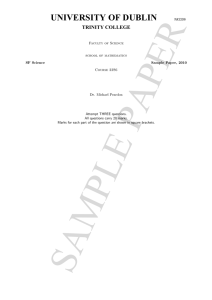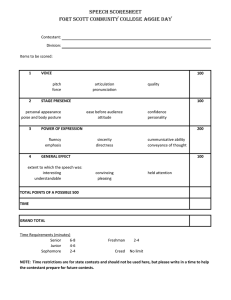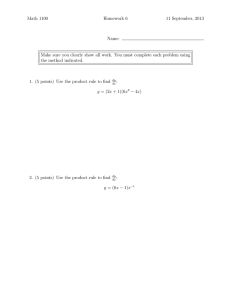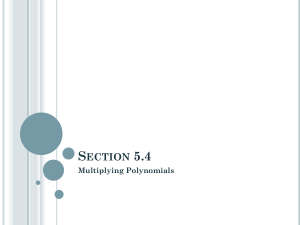Problem
advertisement
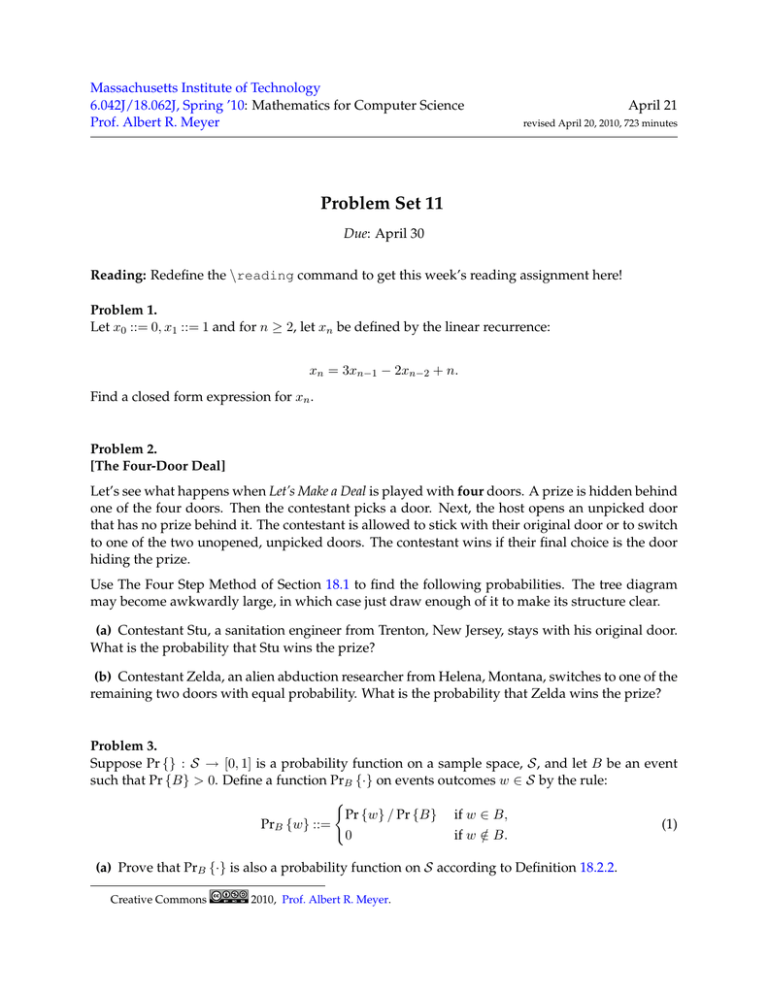
Massachusetts Institute of Technology
6.042J/18.062J, Spring ’10: Mathematics for Computer Science
Prof. Albert R. Meyer
April 21
revised April 20, 2010, 723 minutes
Problem Set 11
Due: April 30
Reading: Redefine the \reading command to get this week’s reading assignment here!
Problem 1.
Let x0 ::= 0, x1 ::= 1 and for n ≥ 2, let xn be defined by the linear recurrence:
xn = 3xn−1 − 2xn−2 + n.
Find a closed form expression for xn .
Problem 2.
[The Four-Door Deal]
Let’s see what happens when Let’s Make a Deal is played with four doors. A prize is hidden behind
one of the four doors. Then the contestant picks a door. Next, the host opens an unpicked door
that has no prize behind it. The contestant is allowed to stick with their original door or to switch
to one of the two unopened, unpicked doors. The contestant wins if their final choice is the door
hiding the prize.
Use The Four Step Method of Section 18.1 to find the following probabilities. The tree diagram
may become awkwardly large, in which case just draw enough of it to make its structure clear.
(a) Contestant Stu, a sanitation engineer from Trenton, New Jersey, stays with his original door.
What is the probability that Stu wins the prize?
(b) Contestant Zelda, an alien abduction researcher from Helena, Montana, switches to one of the
remaining two doors with equal probability. What is the probability that Zelda wins the prize?
Problem 3.
Suppose Pr {} : S → [0, 1] is a probability function on a sample space, S, and let B be an event
such that Pr {B} > 0. Define a function PrB {·} on events outcomes w ∈ S by the rule:
�
Pr {w} / Pr {B} if w ∈ B,
PrB {w} ::=
(1)
0
if w ∈
/ B.
(a) Prove that PrB {·} is also a probability function on S according to Definition 18.2.2.
Creative Commons
2010, Prof. Albert R. Meyer.
2
Problem Set 11
(b) Prove that
PrB {A} =
Pr {A ∩ B}
Pr {B}
for all A ⊆ S.
Problem 4.
Taking derivatives of generating functions is another useful operation. This is done termwise, that
is, if
F (x) = f0 + f1 x + f2 x2 + f3 x3 + · · · ,
then
F � (x) ::= f1 + 2f2 x + 3f3 x2 + · · · .
For example,
1
=
(1 − x)2
so
H(x) ::=
�
1
(1 − x)
��
= 1 + 2x + 3x2 + · · ·
x
= 0 + 1x + 2x2 + 3x3 + · · ·
(1 − x)2
is the generating function for the sequence of nonegative integers. Therefore
1+x
= H � (x) = 1 + 22 x + 32 x2 + 42 x3 + · · · ,
(1 − x)3
so
x2 + x
= xH � (x) = 0 + 1x + 22 x2 + 32 x3 + · · · + n2 xn + · · ·
(1 − x)3
is the generating function for the nonegative integer squares.
(a) Prove that for all k ∈ N, the generating function for the nonnegative integer kth powers is a
quotient of polynomials in x. That is, for all k ∈ N there are polynomials Rk (x) and Sk (x) such
that
�
�
Rk (x)
n
[x ]
= nk .
(2)
Sk (x)
Hint: Observe that the derivative of a quotient of polynomials is also a quotient of polynomials. It
is not necessary work out explicit formulas for Rk and Sk to prove this part.
(b) Conclude that if f (n) is a function on the nonnegative integers defined recursively in the form
f (n) = af (n − 1) + bf (n − 2) + cf (n − 3) + p(n)αn
where the a, b, c, α ∈ C and p is a polynomial with complex coefficients, then the generating func­
tion for the sequence f (0), f (1), f (2), . . . will be a quotient of polynomials in x, and hence there is
a closed form expression for f (n).
Hint: Consider
Rk (αx)
Sk (αx)
Massachusetts Institute of Technology
6.042J/18.062J, Spring ’10: Mathematics for Computer Science
Prof. Albert R. Meyer
Solutions cover sheet
April 21
Student’s Solutions to Problem Set 11
Your name:
Due date:
April 30
Submission date:
Circle your TA/LA:
Megumi
Tom
Richard
Eli
Collaboration statement: Circle one of the two choices and provide all pertinent info.
1. I worked alone and only with course materials.
2. I collaborated on this assignment with:
got help from:1
and referred to:2
DO NOT WRITE BELOW THIS LINE
Problem
Score
1
2
3
4
Total
Creative Commons
2010, Prof. Albert R. Meyer.
People other than course staff.
2
Give citations to texts and material other than the Spring ’10 course materials.
1
MIT OpenCourseWare
http://ocw.mit.edu
6.042J / 18.062J Mathematics for Computer Science
Spring 2010
For information about citing these materials or our Terms of Use, visit: http://ocw.mit.edu/terms.


